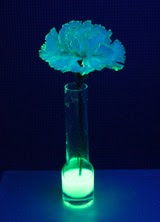Why is hydrogen peroxide stored in dark bottles?
You may have noticed that the hydrogen peroxide in your school
laboratory is always stored in a dark tinted bottle. Ever wondered
why?
Check out this video of Hydrogen Peroxide.
Chemically known as H2O2, Hydrogen Peroxide is a chemical that has a variety of uses. Available as a pale blue liquid that is slightly more viscous than water, Hydrogen peroxide is a weak acid. Due to its strong oxidizing nature, hydrogen peroxide is often used as a bleaching agent. Peroxides are a class of chemical compounds where two oxygen atoms are linked with each other by a single covalent bond.
Hydrogen peroxide was first discovered by Louis Jacques Thénard in 1818. This was achieved by reacting barium peroxide with nitric acid. Thénard’s process of creating hydrogen peroxide was widely used till the end of the 19th century.
Hydrogen Peroxide is produced naturally as by-product of oxygen metabolism. Most living beings have peroxidases enzymes that decompose small quantities of hydrogen peroxide present into water and oxygen. Hydrogen Peroxide can be produced indirectly by hydrogenation and oxidation of an anthraquinone. A direct method of hydrogenation not only hydrogenates O2 in H2O2 but also convert H2O2 into water.
A new method of preparing hydrogen peroxide involves treating carbon support with either nitric or acetic acid. This is then dried. Gold and palladium, is then added to this support results in a reusable catalyst that produces H2O2 with minimal conversion to H2O.
Hydrogen peroxide is used primarily as a disinfectant and as a bleaching agent. Hydrogen peroxide was primarily used for pulp and paper bleaching. Today, it is growing more popular because it is seen as an environmentally friendly alternative to chlorine. This chemical is important for producing the PCB’s that are used in computers and other electronic substances. It is used as a monopropellant to fuel small engines in satellites.
In your homes you might find hydrogen peroxide in hair bleach. As an antiseptic it is used to clean wounds. Mixed with baking soda and salt it can be used as toothpaste.
The packaging of hydrogen peroxide in brown bottles is essential to ensure that it retains its chemical properties. If hydrogen peroxide is heated or is exposed to trace amounts of metal or metal ions it turns into water or oxygen. Glass bottles sometimes have small amounts of alkali metal ions dissolved in it. This is why plastic bottles or glass bottles coated with wax are used instead. The brown tint of the bottle prevents light being absorbed by the solution, preventing the oxidation and reduction reaction.
Check out this video of Hydrogen Peroxide.
Continue reading..
What is hydrogen peroxide?
Chemically known as H2O2, Hydrogen Peroxide is a chemical that has a variety of uses. Available as a pale blue liquid that is slightly more viscous than water, Hydrogen peroxide is a weak acid. Due to its strong oxidizing nature, hydrogen peroxide is often used as a bleaching agent. Peroxides are a class of chemical compounds where two oxygen atoms are linked with each other by a single covalent bond.
The discovery of hydrogen peroxide
Hydrogen peroxide was first discovered by Louis Jacques Thénard in 1818. This was achieved by reacting barium peroxide with nitric acid. Thénard’s process of creating hydrogen peroxide was widely used till the end of the 19th century.
Making hydrogen peroxide
Hydrogen Peroxide is produced naturally as by-product of oxygen metabolism. Most living beings have peroxidases enzymes that decompose small quantities of hydrogen peroxide present into water and oxygen. Hydrogen Peroxide can be produced indirectly by hydrogenation and oxidation of an anthraquinone. A direct method of hydrogenation not only hydrogenates O2 in H2O2 but also convert H2O2 into water.
A new method of preparing hydrogen peroxide involves treating carbon support with either nitric or acetic acid. This is then dried. Gold and palladium, is then added to this support results in a reusable catalyst that produces H2O2 with minimal conversion to H2O.
Hydrogen Peroxide is produced naturally as by-product of oxygen metabolism.
Uses of hydrogen peroxide
Hydrogen peroxide is used primarily as a disinfectant and as a bleaching agent. Hydrogen peroxide was primarily used for pulp and paper bleaching. Today, it is growing more popular because it is seen as an environmentally friendly alternative to chlorine. This chemical is important for producing the PCB’s that are used in computers and other electronic substances. It is used as a monopropellant to fuel small engines in satellites.
In your homes you might find hydrogen peroxide in hair bleach. As an antiseptic it is used to clean wounds. Mixed with baking soda and salt it can be used as toothpaste.
Brown bottles and peroxide
The packaging of hydrogen peroxide in brown bottles is essential to ensure that it retains its chemical properties. If hydrogen peroxide is heated or is exposed to trace amounts of metal or metal ions it turns into water or oxygen. Glass bottles sometimes have small amounts of alkali metal ions dissolved in it. This is why plastic bottles or glass bottles coated with wax are used instead. The brown tint of the bottle prevents light being absorbed by the solution, preventing the oxidation and reduction reaction.


Comments
Post a Comment